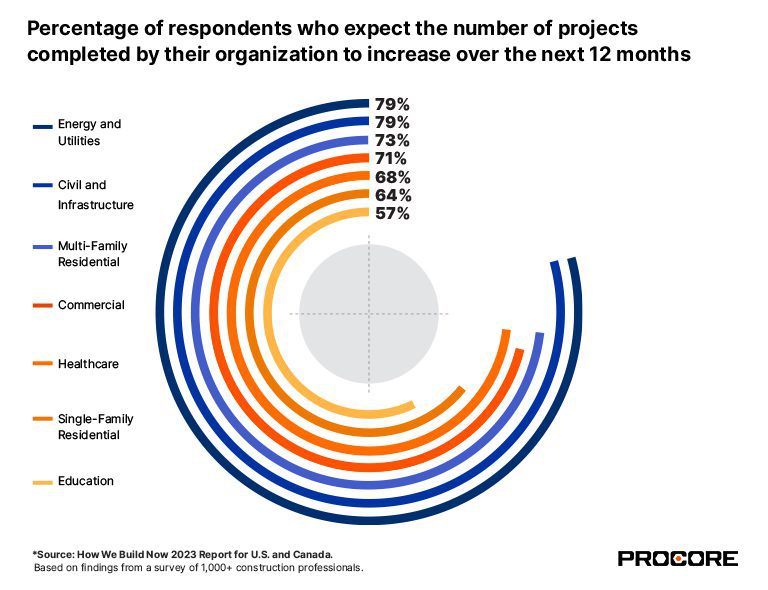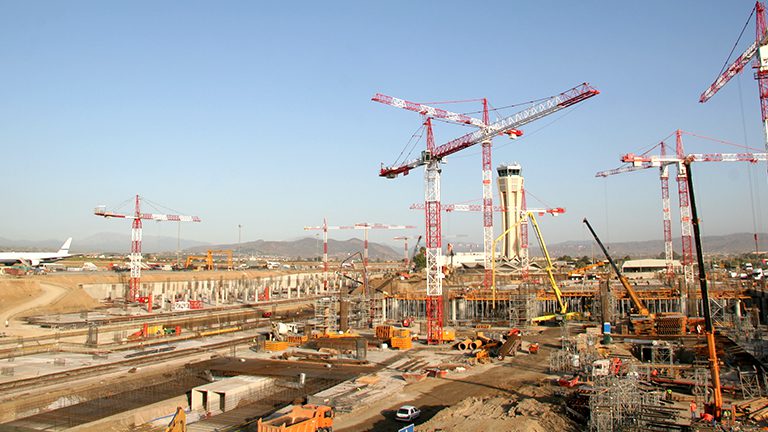In the ever-evolving world of construction, adapting to change is key to long-term success. One strategy that has proven invaluable for construction companies is diversification. In this article, we explore the benefits of having a diversified business, specifically the coexistence of civil and vertical construction teams within a single company. While diversification in business operations has its advantages, a diversified tech stack is not always the best path forward.
Diversification as a growth and risk management lever
Diversification, often viewed as a risk management strategy, is more than just a safety net; it’s a powerful tool for construction companies. One of the primary drivers of diversification in construction is the cyclical nature of the industry. When one sector experiences a downturn, others may be flourishing. By participating in multiple sectors like residential, commercial, industrial and civil construction, companies can balance their revenue streams. This approach helps mitigate the adverse effects of economic downturns in any one sector.
Adapting to shifting tides
The value of diversification becomes even more evident in the current landscape, where we see pronounced growth in civil and infrastructure construction compared to a slowdown in the commercial and residential sectors. This trend is substantiated by a recent survey encompassing the insights of over 1,000 construction professionals.

Industry leaders setting the trend
It comes as no surprise that some of the largest builders in North America have embraced diversification across various industry segments. Moreover, many more companies are exploring new frontiers, such as heavy civil and renewables, in their pursuit of sustainable growth.
In a comprehensive report by the Associated General Contractors (AGC) and Procore, focused on civil and infrastructure construction, respondents highlighted their involvement in two major construction sectors. This compelling data reinforces the idea that diversification is not only a strategy for risk mitigation but a well-proven approach for achieving growth and resilience in the construction industry.
Civil and commercial construction within an organization
In a diversified construction business, the coexistence of civil and commercial teams goes beyond mere cohabitation; it’s a strategic imperative. Civil construction projects, such as infrastructure development and roads, often demand a unique set of skills, resources, and regulatory knowledge that significantly differs from their commercial counterparts. Consequently, having specialized teams dedicated to each project type makes perfect sense.
This differentiation manifests in various ways. While a few companies may have teams that span both commercial and civil construction, the majority opt for dedicated teams, focusing exclusively on each of these sectors. As businesses expand in size and complexity, these teams often evolve into separate divisions or distinct business units. Within these units, they typically maintain their own operational infrastructure, encompassing essential functions like business development, financial management, and technology resources.
While this separation undoubtedly enhances specialization and operational efficiency, it can inadvertently give rise to silos, which may lead to inefficiencies. A good example of this can be observed in the utilization of core technology systems that power construction projects. The challenge lies in ensuring that these technology systems remain cohesive and interoperable across diverse teams, bridging the specialized divisions to maximize efficiency and innovation.
Civil and commercial teams on one tech platform
In the dynamic world of diversified construction, where civil and commercial teams coexist, a unified tech stack can be a game-changer.
Here’s how a unified technology infrastructure can bring efficiency and enterprise-wide visibility:
Large-scale projects, such as airports or transit hubs, often necessitate the seamless collaboration of both civil and commercial teams. With a unified tech stack, these teams can operate as one cohesive unit, leveraging their respective expertise and resources. This synergy is particularly crucial in mega-projects where intricate coordination is paramount for success.
Consider Skanska’s Lynnwood Link Extension (L300) project as an example. This $905 million 3.7 mile light rail transit extension from NE 200th Street in Shoreline to Lynnwood Transit Center is a joint venture between Skanska USA Building and Skanska USA Civil and capitalizes on the different business units’ divisions’ combined expertise. Having both teams working on the same platform (in this case Procore) helped improve collaboration on communication on a complex multi-year project.
Enhanced efficiency
To grasp the tangible benefits of enhanced efficiency through a unified tech stack, consider the experience of Nabholz Construction. Much like other diversified construction firms, Nabholz operates in a multifaceted landscape, undertaking projects spanning commercial, civil, and infrastructure domains. They wear different hats, acting as both general contractors and self-performing entities.
A notable challenge they encountered was optimizing project management across a wide spectrum of project types. In their case, civil and infrastructure projects, such as highway construction and utility installations, presented stark contrasts to the construction of hospitals. These projects brought intricate demands that demanded meticulous attention to detail.
Chris Wright, EVP of Operations Support at Nabholz, emphasized the power of a unified tech stack:
Being able to put everything in one tool and have everybody looking at the same information creates a new sense of direction.”
– Chris Wright, Nabholz
Nabholz’s experience underscores how a unified tech stack can enhance efficiency, especially in diversified construction companies by fostering seamless collaboration and information sharing, facilitating quicker decisions and more effective project delivery.
Greater visibility into enterprise-wide risk
In a diversified construction business, enterprise-wide risk management is paramount. A single source of truth can provide a comprehensive view of risks across various sectors and projects. By centralizing data and analytics, decision-makers can gain insights into potential risks, enabling them to make informed strategic decisions. This enhanced visibility allows for proactive risk mitigation and improved adaptability.
Simplified data reporting and analysis, driven by consistent reporting standards across business units and teams, offer additional benefits. This streamlining not only helps identify trends but also reveals areas for improvement, ultimately fostering greater standardization across the organization.
In conclusion, while diversification in the construction industry can bring numerous benefits, a diversified business doesn’t necessarily require a fragmented tech infrastructure. A unified tech stack serves as the bridge that unites civil and commercial teams when needed, fosters efficiency across all levels, and enhances visibility for effective risk management. By embracing a cohesive technology ecosystem, diversified construction companies can position themselves for success in an ever-evolving market.

Leave a Reply